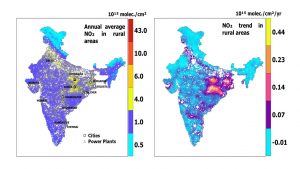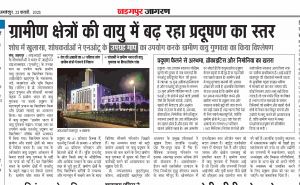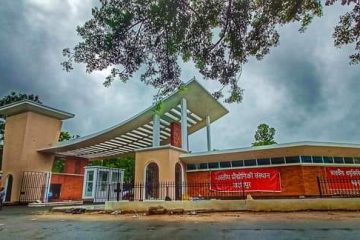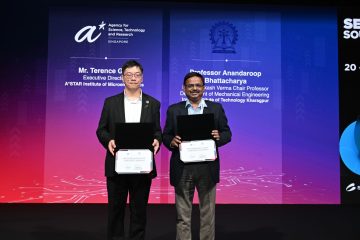Researchers from Indian Institute of Technology (IIT) Kharagpur have found increasing atmospheric pollution in rural India using Nitrogen Dioxide (NO2) measurements from satellites. Prof. Jayanarayanan Kuttippurath and Research Scholar Mansi Pathak of Centre for Ocean, River, Atmosphere and Land Sciences (CORAL) of IIT Kharagpur analysed the significant impact of urban pollution on the air quality of rural India by differentiating the pollution in two zones – rural and urban – and assessing the extent of air pollution in rural India. The researchers found that air pollution is not typically an urban phenomenon but can also affects the environment in rural perimeter. They conducted an analysis of the rural air quality to assess the extent of air pollution by measurements of NO2 through satellite imaging. The analysis carefully delineates the rural and urban regions of India, to examine the unheeded rural air pollution. Most air pollution assessments till date, discussed only the urban air quality issues. This analysis exposes increasing trends (0.05–0.44×1015molec./cm2/yr) of NO2 in the rural regions of India.
The study titled “Air Quality Trends in Rural India: Analysis of NO2 Pollution using Satellite Measurements,” highlights that rural sources account for 41 per cent of the overall NO2 pollution in India of which 45 per cent and 40 per cent are from transportation and power sectors, respectively. As the sources of NO2 are well coupled to the industrial and economic upliftment of a nation, the analyses for the rural regions show distinct seasonal changes with the highest value (2.0 1015 molecules per cm2) in winter and the lowest in monsoon (1.5 1015 molecules per cm2) seasons.

Prof. Jayanarayanan Kuttippurath
CORAL
IIT Kharagpur
“What we observe is that there is a decline in air quality in rural India in terms of our NO2 analysis, which is not beyond the threshold levels now, except in regions such as Delhi and suburbs and eastern India. However, given the positive trend in NO2 concentration, the high rate of urbanization and relocation of industries to suburbs, growing population and development activities, other regions of India would also cross the pollution threshold to impact the health of its people, and thus, our massive rural population. This is the real concern and it is the right time to take appropriate actions to control the atmospheric pollution in rural India,” explained Prof. Jayanarayanan Kuttippurath of CORAL, IIT Kharagpur.
Air pollution is one of the biggest problems in India’s major cities. Comparison of pollutant-wise highest health risk values show that NO2 is about 19 times more harmful than Particulate Matter (PM) and about 25 times more risky than that of Sulphur Dioxide (SO2) . The population residing in the regions of high NO2 such as in the proximity of power plants, industries, cities, and in the areas above the permissible limit, are prone to be at high risk of adverse health effects such as asthma, bronchitis, pneumonia and cardiovascular diseases.

Ms. Mansi Pathak
Research Scholar
IIT Kharagpur
Research Scholar, IIT Kharagpur and lead author of the paper, Ms. Mansi Pathak, stated, “We usually think the atmospheric pollution exists only in cities or it is just an urban threat. The air quality standards in rural regions are often neglected. However, our analysis suggests that it is high time to shift our focus to rural regions and examine the pollution levels and health issues of rural India. This is of paramount importance for a country like India, as rural areas have about 67 per cent of the country’s population (947 million) as of 2020 and public health today stands out to be the utmost priority globally.”
The indirect impact of NO2 on global climate change is not less with a net cooling effect attributed to the oxidation-fueled aerosol production.

Figure: The average concentration and long-term trends in atmospheric NO2 in India for the period 1997-2019.
High Nitrogen Oxide (NO) – which includes Nitric Oxide and Nitrogen Dioxide – levels in the troposphere can alter ozone formation, contribute to nitrate aerosol formation and acid deposition and affect regional climate.
Prof. Kuttippurath said though, other Indian rural regions are under permissible limits of CPCB, the increasing trends in NO2 would surpass the standards in future if no controlling measures are implemented, which is a serious concern.
This study suggests the need for taking action towards improving rural air quality to reduce the impact of air pollution on the large rural population of India. Although NO2 is a non-abundant gas, its indirect impact on global climate change is likely to be greater, with a net cooling effect attributed to the oxidation-fueled aerosol production. NOx levels in the troposphere can alter ozone formation, contribute to nitrate aerosol formation, and acid deposition and affect regional climate. The regions covered in this study are Indo-Gangetic plain, Central India, North-West India, Peninsular India, Hilly Region and North-East India where the authors analysed atmospheric NO2 concentration in different regions of India for the period 1997-2019.

Figure: Rural and urban atmospheric NO2 concentration in different regions of India for the period 1997–2019.
“Regulations similar to the Bharat Stage norms (for limiting vehicular emissions) need to be implemented in thermal power plants and industries located in both rural and urban regions, to restrict the overall NO2 pollution in rural India. Introducing new natural gas-fed power plants or using selective catalytic reduction (SCR) in older power plants can also reduce emissions, and thus, the NO2 pollution in rural India,” pointed out the researchers.
Publication Links: https://doi.org/10.1039/D2EM00293K
Media Coverage:

| PTI | UNI | Indian Express |
| Economic Times | Dainik Jagran | Business Standard |
| The Print | IBC 24 | Neo Science Hub |
Contact Person: Prof. Jayanarayanan Kuttippurath of CORAL, IIT Kharagpur
Email: jayan@coral.iitkgp.ac.in
Edited By : Poulami Mondal, Digital & Creative Media Executive (Creative Writer)
Email: poulami.mondal@iitkgp.ac.in, media@iitkgp.ac.in, Ph. No.: +91-3222-282007
Follow us on: Facebook – IIT Kharagpur; Twitter – @IITKgp; Instagram – @iit.kgp; LinkedIn – Indian Institute of Technology
For news visit: https://kgpchronicle.iitkgp.ac.in/



